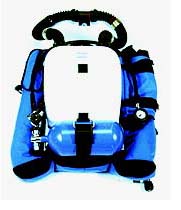of depth. As you inhale, the air from this breathing bag flows into your
lungs. If you should happen to need more air than is contained in the bag, a
bypass valve will enable you to get additional air directly from the tank.
As you exhale, the air flows through a CO2 scrubber and back into the breathing bag.
Since enriched air is constantly flowing into the breathing bag from the tank, eventually
the pressure will build up. A pressure relief value (similar to what you'd use on a dry
suit) allows the excess pressure to be released. The exhaust flow rate from this value is
typically about 1/5th as much as you'd have with open circuit scuba.
The CO2 scrubber is a canister containing a CO2 absorbant based on calcium hydroxide.
It looks like kitty litter. CO2 forms an acid when dissolved in water. The moisture in
your breath provides adequate moisture to allow the CO2 to react with the calcium
hydroxide to form solid calcium carbonate and H2O. The calcium carbonate chaulk remains
mixed with the absorbant material. The heat and moisture generated as a result of this
reaction means the air you breath back in is warm and moist instead of cold and dry - no
more dry throats!
Since you are reusing most of the air, you need a smaller tank for the same amount of
breathing time. The standard tank used with the Dolphin is a 28cf aluminum. This tank will
give you well more than an hour of bottom time. A larger tank can obviously increase this
significantly, although the CO2 scrubber material should be changed after every two hours
of use.
One of the characteristics of the rebreather that takes a little getting used to is
buoyancy. Since the air you breathe out goes into the breathing bag, your buoyancy doesn't
change as you inhale and exhale. This has both pros and cons - your buoyancy is much more
constant than with standard scuba, but you can't use your lungs for subtle buoyancy
control.
Rebreather Downsides
There are a few downsides to using a rebreather, besides cost (the Draeger Dolphin is
about $3000). The Nitrox mix in the tank is typically much richer than what you would
breath using open circuit scuba. This limits the maximum operating depth (MOD) that it can
be used for. If you don't have an oxygen sensor (see discussion below) your MOD limit is
based on the O2 percentage in your tank. If you're diving 50% oxygen, for example, your
MOD limit is only 60 feet if you want to stay below a PPO2 of 1.4 (safe maximum partial
pressure of O2).
A rebreather also requires more maintenance than open circuit scuba. After each dive,
you need to take the system apart to make sure that you had no leakage. This
took about 15-20 minutes for me, although I suspect that once you had more experience,
you'd be able
to do this in less time. After every two hours of diving, you need to change the CO2
scrubber material. This only takes a few minutes when the system is apart, but adds to the
maintenance. Ultimately, the added maintenance over open-circuit scuba is why I
decided to sell my rebreather. On boat dives, there was not enough time between
dives to service both my camera and the rebreather.
The rebreather is also much bulkier for travel, particularly since you generally need to
take your own tanks since most dive shops/resorts don't have tanks of the right size or
with the right fittings. You also probably need to take the CO2 scrubber material with you
depending on where you're going.
You also have to find a dive shop that will supply you with 40% or greater Nitrox
mixes. Most dive shops are not equipped for this.
Dive Computer with PPO2 Sensor
To get the most out of the Draeger Dolphin and to minimize the risk, you can use a dive
computer with integral O2 sensor. I used the Cochran Lifeguard PPO2 which has a hoseless O2
sensor that mounts in the inhalation hose. This allows the computer to constantly monitor
the PPO2 (and therefore the PPN2) and determine both N2 absorption and longterm PPO2
effects.
Since the actual PPO2 levels that you breath from the breathing bag are less than the
tank PPO2, this allows you to safely use the rebreather at greater depths than would be
indicated by the MOD of the tank gas. The Cochran has an alarm if you exceed a preset PPO2
or a preset MOD.
One of the most significant dangers of using a rebreather is Hypoxia - running out of
oxygen. Since the rebreather recycles the air you're breathing, you can continue to breath
the same air in and out, completely depleting the oxygen in the air if there is no source
to replenish the oxygen. It is hard to tell until it is too late that your tank is out of
gas, the valve is not open, or something is wrong with the regulator(s) that feed the gas
into the breathing bag.
Good training and sensible use of the rebreather can certainly reduce these risks
considerably, but using an oxygen sensor with an alarm on low PPO2 can insure that you are
immediately aware when this situation is occuring.
The Cochran unit is fairly expensive. I believe that Draeger has since released their own O2
sensing computer which provides this added safety and convenience at lower cost.
